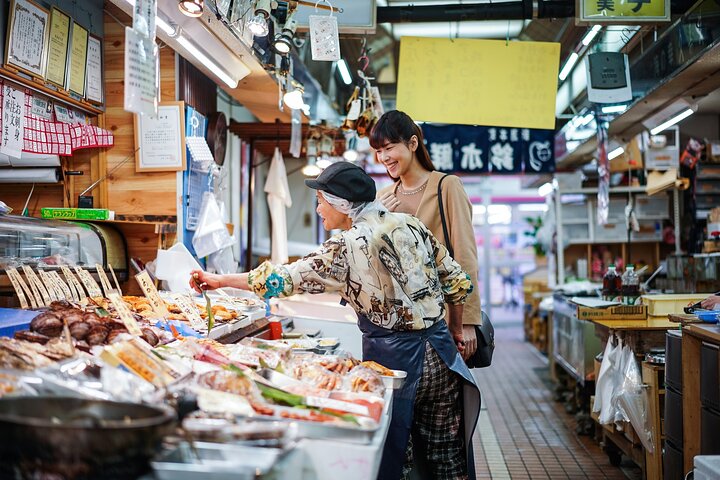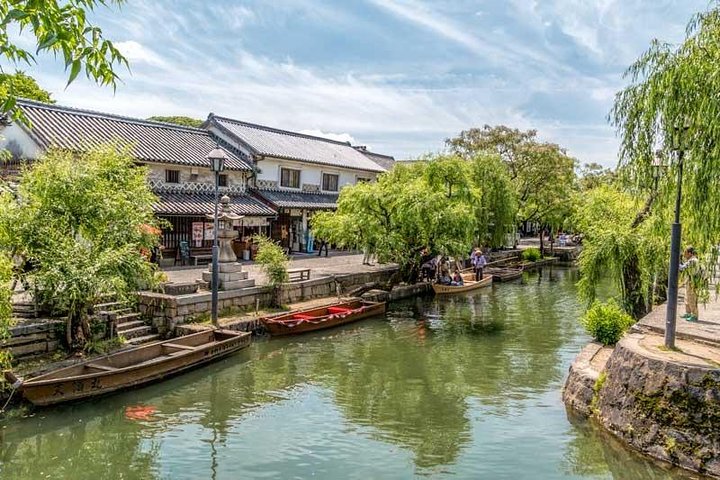Discover Tokyo’s charm with a private guided tour and authentic Kimono tea ceremony. Immerse in culture, history, and tradition in just 5 hours.
Discover Tokyo’s charm with a private guided tour and authentic Kimono tea ceremony. Immerse in culture, history, and tradition in just 5 hours.
-
Asakusa - Asakusa (浅草) is the heart of Tokyo’s shitamachi, or “low city,” a district where the essence of Tokyo from past decades is still alive.
The main highlight of Asakusa is Sensoji, a highly popular Buddhist temple established in the 7th century. Visitors reach the temple through Nakamise, a shopping street that has been offering traditional…
- Asakusa - Asakusa (浅草) is the heart of Tokyo’s shitamachi, or “low city,” a district where the essence of Tokyo from past decades is still alive.
The main highlight of Asakusa is Sensoji, a highly popular Buddhist temple established in the 7th century. Visitors reach the temple through Nakamise, a shopping street that has been offering traditional local snacks and tourist souvenirs for centuries.
- Tsukiji Fish Market - Discover the historic fish market in Tokyo!
- Meiji Jingu Shrine - Meiji Shrine (明治神宮, Meiji Jingū) is dedicated to the deified spirits of Emperor Meiji and Empress Shoken. Situated next to the bustling Harajuku Station on the JR Yamanote Line, Meiji Shrine and the nearby Yoyogi Park form a large forested area within the densely populated city. The expansive shrine grounds feature walking paths perfect for a leisurely stroll.
The shrine was completed and dedicated to Emperor Meiji and Empress Shoken in 1920, eight years after the emperor’s passing and six years after the empress’s. It was destroyed during World War II but was subsequently rebuilt.
- Koishikawa Korakuen Garden - Koishikawa Korakuen is one of Tokyo’s oldest and finest Japanese gardens. Constructed in the early Edo Period (1600-1867) at the Tokyo residence of the Mito branch of the ruling Tokugawa family, the garden was named Korakuen after a poem encouraging rulers to seek pleasure only after ensuring their people’s happiness. Koishikawa is the district where the garden is located.
Admission fee
Adult: 300 JPY
Children and seniors (+65): 150 JPY
- Hamarikyu Gardens - Hama Rikyu (浜離宮, Hama Rikyū) is a large, beautiful landscape garden in central Tokyo. Situated alongside Tokyo Bay, Hama Rikyu features seawater ponds that change with the tides and a teahouse on an island where visitors can relax and enjoy the view. The traditional garden contrasts sharply with the skyscrapers of the nearby Shiodome district.
-
Imperial Palace - This tour does not include access to the interior of the Imperial Palace
The current Imperial Palace is located on the former site of Edo Castle, a vast park area surrounded by moats and massive stone walls in central Tokyo, a short walk from Tokyo Station. It is the residence of Japan’s Imperial Family.
Edo Castle was once the seat of the Tokugawa shogun, who ruled Japan from 1603 until 1867. In 1868, the shogunate was overthrown, and the capital and imperial residence were moved from Kyoto to Tokyo. In 1888, a new Imperial Palace was completed. The palace was destroyed during World War II and rebuilt in the same style afterward.
- Rikugien Garden - Rikugien (六義園) is often regarded as Tokyo’s most beautiful Japanese landscape garden, alongside Koishikawa Korakuen. Built around 1700 for the 5th Tokugawa Shogun, Rikugien means “six poems garden” and recreates 88 scenes from famous poems in miniature. The garden is a prime example of an Edo Period strolling garden, featuring a large central pond surrounded by manmade hills and forested areas, all connected by a network of trails.
- Takeshita Street - Harajuku (原宿) refers to the area around Tokyo’s Harajuku Station, located between Shinjuku and Shibuya on the Yamanote Line. It is the hub of Japan’s most extreme teenage cultures and fashion styles, but also offers shopping for adults and some historic sights.
The epicenter of Harajuku’s teenage culture is Takeshita Dori (Takeshita Street) and its side streets, lined with trendy shops, fashion boutiques, used clothing stores, crepe stands, and fast food outlets catering to fashion-conscious teens.
- Nezu - Miraculously spared from major damage during world wars and natural disasters, Yanaka and Nezu—two neighborhoods that form part of shitamachi, Tokyo’s old downtown—retain their charm from the last century. Historical sites like Yanaka Cemetery and Nezu Shrine are nestled among shitamachi’s narrow back alleys, traditional wooden houses, izakaya pubs, atmospheric coffee shops, and retro stores selling old-style sweets and snacks. Here, visitors can step back in time to a more leisurely, genteel Tokyo.
- Shibuya Crossing - Known as the busiest crossing in the world, Shibuya Scramble is a marvel of modern urban life. Visitors can also see the loyal Hachiko dog statue here!
- Tokyo National Museum - The Tokyo National Museum (東京国立博物館, Tōkyō Kokuritsu Hakubutsukan) is the oldest and largest of Japan’s top-level national museums, which also include the Kyoto National Museum, the Nara National Museum, and the Kyushu National Museum. It was initially established in 1972 at Yushima Seido Shrine and later moved to its current location in Ueno Park.
The Tokyo National Museum boasts one of the largest and finest collections of art and archaeological artifacts in Japan, comprising over 110,000 items, including nearly a hundred national treasures. At any given time, about 4,000 different items from the permanent collection are on display. Additionally, temporary exhibitions are held regularly. Excellent English information and audio guides are available.
-
Tokyo Tower - Access is limited to the main deck; the top deck is not included
The retro-chic version of Tokyo Skytree! This vermillion tower has been a symbol of Tokyo for generations and is often seen in the background of many famous animes! - Shinjuku Gyoen National Garden - Shinjuku Gyoen (新宿御苑) is one of Tokyo’s largest and most beloved parks. Located a short walk from Shinjuku Station, the park’s expansive lawns, winding walking paths, and serene scenery offer a peaceful escape from the bustling urban center. In spring, Shinjuku Gyoen becomes one of the city’s best spots to view cherry blossoms.
- Imperial Palace - The current Imperial Palace is situated on the former site of Edo Castle, a vast park area surrounded by moats and massive stone walls in central Tokyo, a short walk from Tokyo Station. It is the residence of Japan’s Imperial Family.
Edo Castle was once the seat of the Tokugawa shogun, who ruled Japan from 1603 until 1867. In 1868, the shogunate was overthrown, and the capital and imperial residence were moved from Kyoto to Tokyo. In 1888, a new Imperial Palace was completed. The palace was destroyed during World War II and rebuilt in the same style afterward.
- Shibamata - Shibamata (柴又) is a neighborhood on Tokyo’s eastern edge, near the Edogawa River, which serves as the natural border between Tokyo and Chiba Prefecture. The town retains its nostalgic charm from days gone by and offers a perfect retreat from modern Tokyo. One of the main attractions is the Shibamata Taishakuten Temple, located not far from the station.
- Meiji Jingu Shrine - Meiji Shrine (明治神宮, Meiji Jingū) is dedicated to the deified spirits of Emperor Meiji and Empress Shoken. Situated next to the bustling Harajuku Station on the JR Yamanote Line, Meiji Shrine and the nearby Yoyogi Park form a large forested area within the densely populated city. The expansive shrine grounds feature walking paths perfect for a leisurely stroll.
The shrine was completed and dedicated to Emperor Meiji and Empress Shoken in 1920, eight years after the emperor’s passing and six years after the empress’s. It was destroyed during World War II but was subsequently rebuilt.
- Akihabara - Akihabara (秋葉原), also known as Akiba after a former local shrine, is a district in central Tokyo renowned for its numerous electronics shops. In recent years, Akihabara has also become recognized as the center of Japan’s otaku (diehard fan) culture, with many shops and establishments dedicated to anime and manga now interspersed among the electronic stores. On Sundays, Chuo Dori, the district’s main street, is closed to car traffic from 13:00 to 18:00 (until 17:00 from October through March).
- Senso-ji Temple - Sensoji (浅草寺, Sensōji, also known as Asakusa Kannon Temple) is a Buddhist temple located in Asakusa. It is one of Tokyo’s most vibrant and popular temples.
Legend has it that in 628, two brothers fished a statue of Kannon, the goddess of mercy, out of the Sumida River. Despite returning the statue to the river, it always came back to them. As a result, Sensoji was built nearby for the goddess Kannon. The temple was completed in 645, making it Tokyo’s oldest temple.
- Odaiba District - Odaiba (お台場) is a popular shopping and entertainment district on a man-made island in Tokyo Bay. It originated as a series of small man-made fort islands (daiba means “fort”), constructed towards the end of the Edo Period (1603-1868) to protect Tokyo from potential sea attacks, specifically in response to Commodore Perry’s gunboat diplomacy.
Over a century later, the small islands were merged into larger ones through massive landfills, and Tokyo embarked on a spectacular development project to transform the islands into a futuristic residential and business district during the extravagant 1980s. However, development slowed significantly after the “bubble economy” burst in the early 1990s, leaving Odaiba nearly vacant.
- HiSUi Tokyo - HiSUi Tokyo offers an exclusive plan for overseas visitors to experience Japanese culture. Try on an authentic kimono and enjoy a Japanese tea ceremony at HiSUi Tokyo!

- Meet up with guide on foot within designated area of Tokyo
- Tea ceremony experience with Kimono at Ginza
- Customizable Tour 2-3 sights
- Licensed Local English Speaking Guide
- Meet up with guide on foot within designated area of Tokyo
- Tea ceremony experience with Kimono at Ginza
- Customizable Tour 2-3 sights
- Licensed Local English Speaking Guide
- Transportation fees, Entrance fees, Lunch, and Other personal expenses
- Private Vehicle
- You cannot combine multiple tour groups.
- Guide Entry fees are only covered for sights listed under What to Expect.
- Transportation fees, Entrance fees, Lunch, and Other personal expenses
- Private Vehicle
- You cannot combine multiple tour groups.
- Guide Entry fees are only covered for sights listed under What to Expect.
This 5-hour walking tour includes a 1-hour tea ceremony experience with Kimono at HiSUi TOKYO in Ginza. Before your tea ceremony, enjoy a 4-hour walking tour with our licensed guide! Your guide will also join the tea ceremony as a translator. Enter the tea room through the Nijiriguchi (a small, square entrance), where you’ll receive a lecture on the…
This 5-hour walking tour includes a 1-hour tea ceremony experience with Kimono at HiSUi TOKYO in Ginza. Before your tea ceremony, enjoy a 4-hour walking tour with our licensed guide! Your guide will also join the tea ceremony as a translator. Enter the tea room through the Nijiriguchi (a small, square entrance), where you’ll receive a lecture on the proper way to enjoy Japanese sweets and green tea. Customize your tour directly with the guide after booking by selecting 2 to 3 spots from the ‘what to expect’ or ‘itinerary’ list. Start time: The start time for the experience may vary. The estimated duration of the experience is about 4 hours from the beginning of the tour. Experience time: The duration of your experience may vary.
For a full refund, cancel at least 24 hours before the scheduled departure time.
For a full refund, cancel at least 24 hours before the scheduled departure time.

















